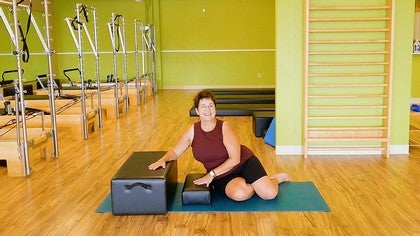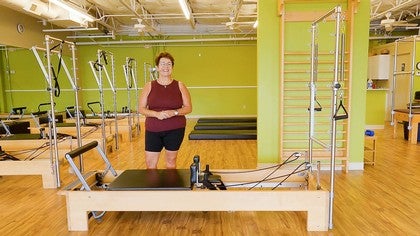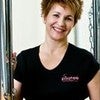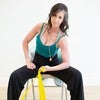Description
About This Video
Transcript
Read Full Transcript
In this session today with the boxes, you'll notice I have different levels of boxes set up. There's a short one, and then there's a regular box we use on the reformer and then I've taken the short one and added it on top, and that'll make that one even higher. For the purpose of today's class, I will be predominantly using this middle box right here to show you the exercises that I want you to be aware of that you can do pre-long box, pre-short box, all the boxes by themselves, different kind of things to get clients either warmed up or do in the middle of a session. So this could be a standalone session, or you can pick and choose some of these exercises to put in the regular classes that you do where you take on Pilates Anytime reformer. So I'm gonna move one of the boxes out of the way.
And we will start with sit to stand. And here I am sitting on the box. So my hands are gonna come out in front any way I can, I'm just gonna try to stand up without using my arms. So I'm gonna stand, the arms come down and then sit, 10 times. So just count 'em with me, three, and four, five, six.
Remember that if this is too low, you can always put the small box on top, seven, and eight, and nine, and 10. Turn around that 10 repetition, get your heart going. Start marching up on the box. If I had my old school leggings on and a little ponytail, I'd be in a step aerobics class, but actually I think I'm stronger now than I was long time ago. Anyway, let's do five more, four, three, two, and one, rest.
With the right foot on the box and the left foot on the floor, take a tiny connection through the back leg and lift up and down. Adding the arms, 10 times, two. (exhales sharply) I'm pushing down with my front leg, pushing up on my back ball of my foot. Three more, two more, last one, come down. Now I'm gonna do that five more times, but I'm gonna linger in the up phase.
Still keeping the ball of my foot down, but almost like I'm gonna lift it up, which I will in a little bit. Three, four, and five. Rest. Now that left leg is getting really tired, so now is a good time to start the going up front with the right leg. So the first step up will be pull myself up with this front leg, touch the box, come down.
Hands can do whatever they need to do. Some people might need to press on this leg. So get the pull up from the front leg. One more time like this, I'm touching the box, I'm coming down. Now when I go up, I'm gonna not touch the box with my left leg, but I know I can if I have to.
Five times, press down, lift up, all the way down. Lift up, all the way down. Press the right foot down as I lift up. So I'm doing knee extension and hip extension. One more time.
Woo. And then down. Rest. Understanding that you can do it on that short box. You can add, when I say short box, I mean that moon box or you can add that moon box if you had somebody that was really tall.
Real live work here, here we go, left leg up, back of the right heel lifts and lowers. And add the arms here, like I'm gonna fly across the room. (exhales sharply) Pushing with the ball of my foot. We do this on the chair, right? 10 times, there's five more, and four.
Push with the back foot and the back tush. Three, two, and one. Rest for a second. Doing five more of those lingering in the up phase. Here we go.
Linger, and low. Linger, and low. You should feel your calf, you should feel the back of your right thigh and the back of your bum. Lower two more. Lingering the up phase, right thigh sufficiently tired.
Good thing 'cause now we're switching to the left leg, pulling up touch, and then down, up, touch the box, down. Knee extension, hip extension on the working leg. Two more here and last one. Now we step up, bring the right knee up and down, up and down. Here's three and four. (exhales sharply)
Last one, five, all the way down, and rest. Really good step up series, lunge series. We'll come back to the box. But now using this little box, I love this because it kind of catches you by surprise. Watch, step on the box with my right leg.
Step up and over. Now this back heel is lifted, so when I come back, it's that quadricep, whoa, step up and over, step up and back, up. There's a tendency to wanna do this and kind of jerk it back, but just try to be slow and deliberate, understanding that it's okay if it feels really hard because this quadricep, you also could get this by walking backwards. Hmm. I'm gonna get three more, and two more.
I gotta keep my right hip happy. I lost count, let's do one more and back. (exhales sharply) Woo. Left leg. (inhales sharply) Now, if you're watching this, you're pressing the back leg down after that heel lifts up.
If you're just doing it and listening, you're trying to step yourself up and over the box, and up and over. So you can linger in any position. I'm gonna get three more, (exhales sharply) and two more, and last one, and come back. Really good, I promise really good. The other thing I love is standing on the box.
Actually, I'm gonna do it like this. You can kind of see me from the side. So put my feet on the box and then you know how the high divers do at the Olympics? And I wonder how they can get their feet back. I'm just gonna go there, 'cause my feet are a little sweaty and I'm gonna try to turn on the back part of my thighs.
I'm gonna try to take the package of my ribs back and then the back of my body. And I'm not gonna lower and raise, but I'm just gonna hold still as best I can looking straight ahead, so bridge of my nose back, there, now I've got it. Now my legs, my heels are not lowering, they're not touching anything. The soles of my feet, so strong and then down. Ooh, we could do that three to five times, but for the sake of today, I'm just gonna do it that once.
Actually let's do it one more time together. Come on, come on, let's do it one more time because the first time was really hard and the second time we wanna see that we can do it and you can put a stick in front of you or look, I'm just pretending like I have a dowel in front of me. And if I stack up all my packages, right, my pelvis, my hips, my ribs, I just feel myself getting long like a rocket to the ceiling. (inhales sharply) (exhales sharply) And then rest down. Awesome.
All right, let's take that box away. Remember, boxes do have benefits. Now long box comes back. So now, have a little interlude here with the abdominal series. I'm gonna be happy to do the abdominal series, give my legs a break.
Coming on the box. We will do five sets of each. Rolling my spine down, pulling my knees in, staying curled up, and here we go. One, two, three, four, five, six, seven, eight, nine, 10, 'cause that equals five, right. Row, double legs, five times, one.
(exhales sharply) Pull the thighs into the belly. And three, (exhales sharply) and four. Last time, five, two legs come up and pulse, pulse, two, and three, and four, and five, reach high, and seven, and eight, and nine, and 10, two legs, double legs lower for five, flex the heels, come up. Point the toes, flex the heels. Here's three, and four, and five.
And now twist two, three, four, five, six, seven, eight, nine, 10, and rest. Woo, turning around. (exhales sharply) A little extension connection, right. So that ab series gives us a little flexion connection. Now with my belly on the box, gonna reach my legs long.
Now this is an interesting concept here that if you feel the box, it's kind of gonna hold your belly in place. And then I'm gonna just reach back and lie flat down on the box. Two legs straighten like a plank. For the sake of my microphone, I'm gonna leave my head lifted, but try to keep your head down a little bit here. So you're gonna lift one, 10 times, four, five, lifting your leg lower than you want to really being mindful that the knee is straight to one rest.
Other leg 10, nine, eight, straighten the knee not lifting too high four, three, two, one, rest. Both the knees come down. With my hands on the side of the box, this might vary depending on how tall everybody is, just give it a try, so two legs long. I'm gonna push my hands down, pull my shoulders back. I lift my chest and then I'm gonna hover my pelvis in this chest forward position, and then I'm gonna put my belly down, bend my knees.
I'm gonna go to my fists to see if I can give myself a little extra lift. There we go. So with that lift in the plank, I'm gonna turn my chest upward and then come level and then down. One more time. It gives me the opportunity to extend and then just kind of feel the action of lifting up after that extension, then pulling forward into the extension and then level and then down, and rest.
Taking your body forward on the box now. And I' love this action for swimming because sometimes on the floor, when we do swimming, if people can't get their arms by their ears, this allows them to keep their arms down. So I can just look at, lift my arm part way partway. Now if I can lift my arm more, of course from my lower trap and shoulder blade, that's fine. And then it's two, two, or it's four, right, four extremities, two legs, two arms, and then hold and then swim slow, and then swim fast, and then swim slow.
Swim fast and rest. Taking yourself one more section over the box. This is actually one of my favorite things to do. (exhales sharply) It's going to allow me to feel my front ribs heavy into the box as my head lowers down. This gives me a nice lengthening in this thoracic lumbar area.
And my trunk is in flexion. So I'm like doing a 100 beats upside down. Now with my hand on my low back, I just want to lift my chest to what I believe is level. And then I'm gonna flex forward, head, chin, chest, flex, and then just lift myself to level. Recognize level, and then lift higher and then return to level, and then flex.
Hands come down, you can flex even more. It's a little pressure on your ribs if you just ate, but I didn't just eat, so it actually feels good like I'm lengthening here. All right, and then bring yourself all the way up and then come to sit on the front edge of the box. Now on the front edge of the box, with your knees bent, your hands on your knees, then you move your arms out to the front. So reach your knees long as if your hands were still there.
And then start to roll your waistline down until you feel like your legs wanna lift. It's different for everybody, it's different day to day. Okay. So push the feet away, push the knees away, but pull the belly back. So you're rolling back and then rolling up.
Maybe roll forward. Unroll your belly. Roll back, start to lift your face. Roll back further. Lift the right leg, lift the left leg, and balance, three breaths.
(exhales sharply) Two, one more time, three, and then bring yourself up. Separate the legs, put your hands all the way down on the mat. If you have any belly skin in the way, just take it out and then push your, hug your thighs, excuse me into your abdomen, right? That's kind of what stomach massage is right on the reformer. So right here, (exhales sharply) my back is relatively lengthened, but I'm gonna nod my head, push the floor down and almost do a cat stretch.
I hope you can see my back rounding a little bit. (exhales sharply) And then I'm going to pull my hands towards the box, and pull my chest forward. So if you will, I'm kind of doing a seated cat cow, pushing the hands down into the floor, pushing my hands away, pushing my feet away as I round my torso. (inhales sharply) (exhales sharply) I'm just exaggerating that breath there. Now I pull my feet back, pull my arms back, and lift my chest.
Now this is tricky here because sometimes people will roll too far forward on their perineum and they'll end up arching their low back. But I just want you to arch your upper back and then press the hands down, round your torso any bit more. And then one more time. (inhales sharply) (exhales sharply) And then bring yourself all the way back. Now that will probably give you a little more range of motion into your back.
If you feel like your leg is gonna lift, go ahead and lift one of the legs and you can go further and then pull that leg to bring you up. (inhales sharply) Roll away, pulling your belly in, rolling that lowest part of your low back and the top is part of your sacrum. Can you stay here and then pull yourself back up? Other leg. Using this to prepare you of course for short box, but you really wanna feel that your hips are free enough to allow your pelvis to curl back.
Sometimes in the short box when your legs are long and your legs are underneath the straps, right, and you're pulling up on two straight legs, it's sometimes hard to roll the pelvis back. Excuse me, so sometimes I think it's a good idea to just not strap the legs initially and really make sure you can work on that roll so that you can get all the different pieces of the pelvis. So coming back up now, we're gonna move the box this way. And then this is just an elevated plank. We've probably done this at some point, right?
So if you have your hands back here on the box, that lets you bend your fingers over the box. If your hands are flat here, you wanna be sure the ribs, I mean, the wrists don't hurt. So we're going here, right. So this is just an elevated plank. Do not downplay an elevated plank for people that have a hard time doing a full plank.
It's gonna be the same thing with back plank, right? So when we do the back plank, we wanna be sure that it's the arms that stay long and the blades come into the body, and then it's my butt that comes out, I reach long and then I lift up, right. So now I'm in this long back plank, which is the back of my body. And then the front plank, of course, in the front of your body, side plank. Now, when you do this side plank, I'm gonna start like this because what I just did try not to do, (chuckles) because if you get into side plank by doing this, you're actually not using the side of your body to come up, you're actually using the front of your body.
Okay. So in the side plank, this is actually gonna be harder because now I'm going to lift up my whole body. So see, my shoulder here are gonna press, and lift. And now I'm using the bottom part of my body up as I press that bottom foot down. Hold and hold and hold and then rest.
Other side. There's also a, I did it again. I do not wanna use this hand. So when you pull yourself up, see my bottom ribs are long now, right, on this side, and then when I come up, they're gonna come level. I used the side of my body to lift up.
the bottom right foot is pressing down to lift the pelvis up, and then I bring myself down and rest right there. So in these planks, really important to recognize where the progression is and where the regression is. And of course never underestimate the power of a plank against the wall, against a chair, against the rungs on the ladder barrel. But then you also need to progress your plank in a different way, right. So we can actually have an elevated plank on the back end.
So an elevated plank on the back end, right, becomes this, hands down, feet out. So the elevated plank on the back end is here. Right, then we can start to push the bottom up and then this will start to become full arm balance on the ladder barrel, right? So I have to really get, watch, my chest to come through and wait over my arms. And then down and up.
Not having a mirror, I don't know if that was anywhere near alignment, but you get the gist. Okay, so we have to treat the concept of an arm balance as coming from the arms and the blades. And if you can't access your arms all the way up over your head here, then it's gonna be hard to do a full arm balance in the head down position. Okay. So sometimes I take the box, like this, this box doesn't weigh very much and I hold it like this and I just hold it up there and you'll see one of my elbows wants to bend, I'll face you this way.
See how that one elbow wants to bend and then I really have to push weight through my pointer finger, I have to push down on my feet and up with my arms. Now that's also an overhead press, right. So when we're lying face down on the long box and pushing the bar over the head, this should be the ultimate journey of the overhead press as well. Now once we understand the step ups and the different things, we can do in and around the box, holding the weighted pole or a set of weights, a lot of those we can also do on the arc barrel with our back shaping against the arc. This is a soft foamy cushion.
And now just by standing on this cushion and being wobbly, that gives the soles of your feet feedback, right. And if you closed your eyes, that's even harder. And if somebody just tossed a little ball at you, that would be a little bit harder as well and you feel your legs, right. So now the exercise can become step up on the cushion, bring one knee in and then go back down. Step up on the cushion, bring the other knee in and lower it back down.
Then, now this isn't a rehab exercise now with that soft cushion on the block and on the box, but it is a challenging exercise. So if you need a dowel in front of you or you need to hold on somebody's hand, you do, or maybe you step on the cushion, right, and you just touch. Maybe you don't lift the leg all the way up, right. So you really try to pull, you try to do knee extension, hip extension, and then up and then down. We know that ankle stability is a part of balance and we have to roll through the feet, right, we have to roll out the feet.
We've gotta do toe extension, ankle, dorsiflexion, all those things. All right. So I'm not gonna do another series on there, I just wanted to show you that. And then, putting this little box back on here again. I just wanna show you sometimes a, we did the sit to stand in the beginning, which was a squat but now I'm gonna use my box as a support.
I just put this here because some people need that. Now the thing here is that I'm not just resting in my knees, my shoulders over my knees, over my toes, that is a low squat, not everybody can do this and that's fine. But if you can, it's a really good exercise. And then you come up, knee extension, hip extension at the same time. So it's a little bit lower squat, it gets into knee flexion.
Really important for ankle dorsiflexion. Okay, so down. So ankle dorsiflexion, right? So I could hang onto this box. My teacher can sit here, face the other direction, of course, right, but then it's giving it weight so that I can sit down.
And when I stand up, I don't just lean forward to stand up, but I push the floor away, knee extension, hip extension, everything stands up. Continuing on with the high box remembering that, of course you could do it with a lower box, taking my foot up here. How high can I get this? Right, how much lineage or long line can I get through this knee and my chest without overarching? So my right knee, that's the down leg is pushing down and back, my front knee pulling me forward, and switch.
Oh, different on this side. Look, this is telling me not to do it 'cause I can't go into hip extension here. So I'm gonna take my little box, and it's gonna be a better accessibility. There we go. So I did it on one, so now I have better accessibility here.
So it's not the size of our belly, right, it's the action of what it's doing, creating this line up. I can take my arms up, but I don't wanna arch here. I'm getting ankle dorsiflexion on this side with weight bearing, hip extension on this side. I'm bringing myself back. All right.
So those are some of the things that we can do using the box either coupled into a reformer session or just some on your own. And you know what, if you don't have a reformer box and you have a chair or you have something, your back porch or something that can let you get up and down, just level change is important for your heart, it's important for your step edge if you will. And all that movement is really good. Thanks for joining me.
Key Connections: Find your 'A-Ha' Moment
Comments
You need to be a subscriber to post a comment.
Please Log In or Create an Account to start your free trial.


















